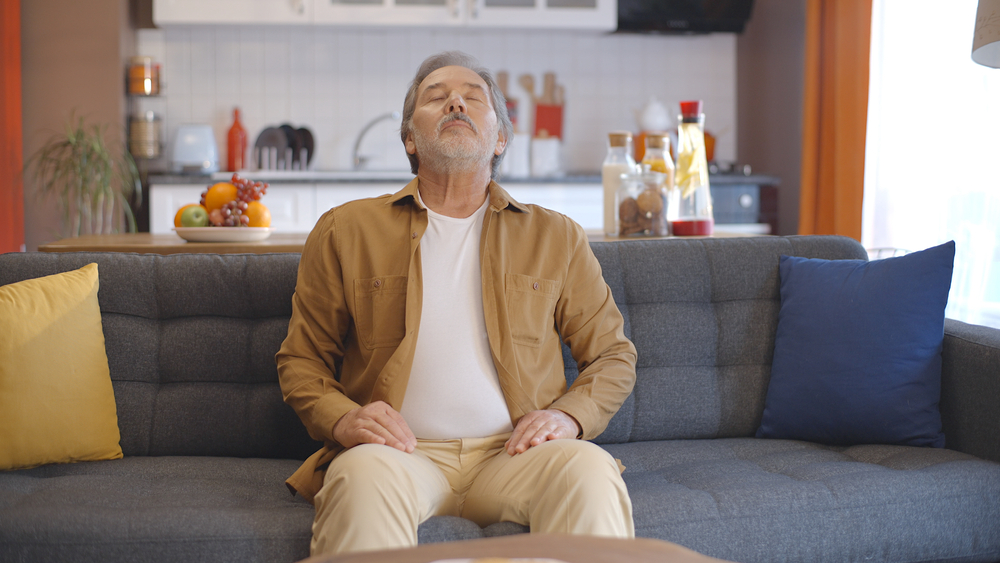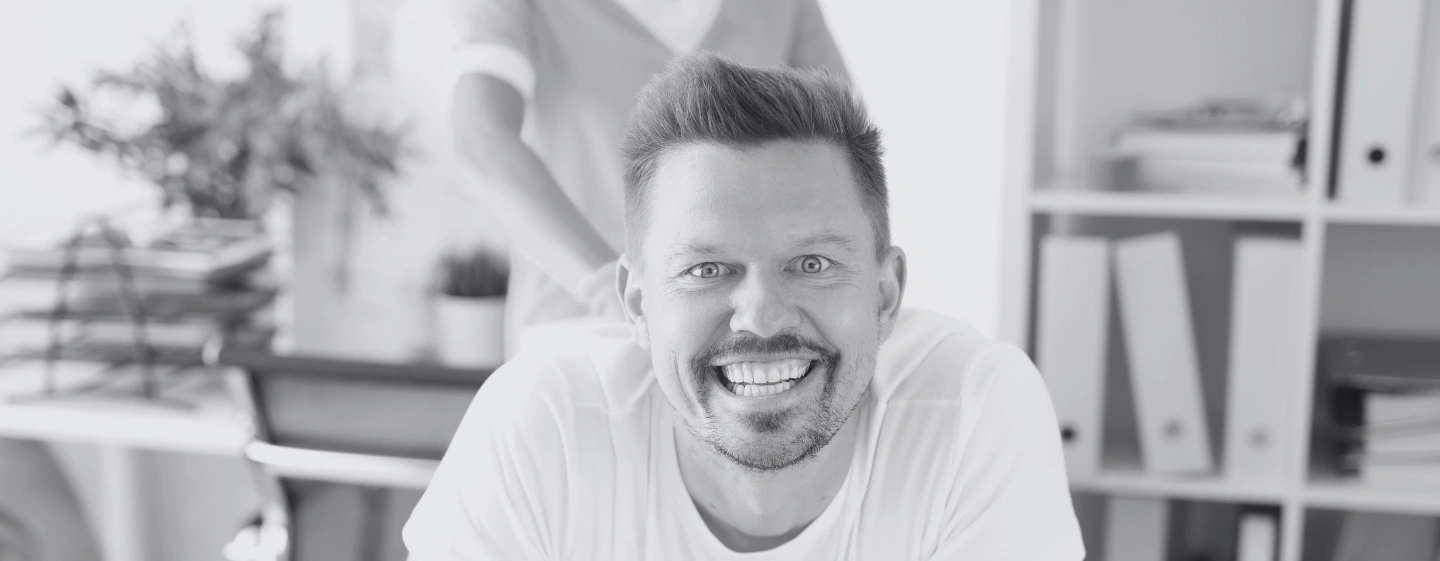You breathe all day without thinking, but how you breathe matters more than you realize, especially as you get older. Your body isn't the same at 60 as it was at 30. Respiratory muscles lose strength. Oxygen uptake decreases. These changes often go unnoticed until everyday tasks feel harder than before.
What seems like just "getting older" may reflect poor breathing patterns. Shallow chest breathing becomes more common, especially under stress. This limits lung capacity and raises heart strain. It can also trigger an errant stress response, spiking stress hormones like cortisol.
Exercising specific breathing methods is a practical way to slow this decline. In particular, deep and diaphragmatic breathing can help counteract age-related limitations. The benefits extend beyond the heart. Breathing exercises relieve stress, calm the nervous system, and improve sleep. These gains support immune function and overall energy levels.
For aging men, paying attention to how they breathe may be one of the simplest ways to stay fit, feel calm, and remain active. This blog explores how proper deep breathing techniques men can help them take charge of their health, one breath at a time.

How Aging Affects Breathing
Breathing may feel simple, but how it changes with age can affect nearly every part of your life. As men grow older, the respiratory system naturally becomes less efficient. The lungs lose elasticity.
The air sacs that exchange carbon dioxide and oxygen stiffen, resulting in a loss of lung volume. At the same time, the diaphragm and intercostal muscles weaken, making deep, controlled breathing more difficult.Posture also plays a role. With age, many men develop a slight forward lean or rounded shoulders.
This compresses the chest cavity and restricts how much the lungs can expand. The result is often a noticeable change in breathing patterns, with less air taken with each breath and more effort required to exhale. These physical changes set the stage for common breathing issues. Shortness of breath during light activity becomes more frequent.
Many men develop shallow, chest-based breathing or even rely on mouth breathing out of habit. With time, this diminishes oxygen absorption and disturbs the equilibrium of carbon dioxide levels in the bloodstream. Sleep-disordered breathing, including obstructive sleep apnea, is also more common in older men. It interrupts rest and limits the overnight oxygen supply.
According to the Journal of Clinical Sleep Medicine, sleep apnea increases significantly with age and is linked to higher cardiovascular risk in men. Breathing problems don't just affect the lungs. They affect stamina, increase fatigue, and can even contribute to brain fog and anxiety. Lower oxygen supply also raises the risk of heart disease and worsens existing health conditions.
The Science and Benefits of Proper Breathing Techniques
When you breathe deeply, the oxygen supply improves. The lungs take in more air, and the body delivers that oxygen to every cell. This helps the mitochondria, which are the cells' energy producers, to work more efficiently.
At the same time, proper breathing removes carbon dioxide more effectively, keeping the body's pH balanced and supporting overall health. Deep breathing exercises also regulate the nervous system. When you slow your breath, the parasympathetic system takes over.
This system helps your body relax, digest food, and recover from stress. As a result, cortisol levels drop, and your blood pressure stabilizes. Even a few minutes of focused breathing each day can reduce overall stress levels. The cardiovascular system also benefits from breath control.
Research found that diaphragmatic breathing significantly improved heart rate variability, a marker linked to better stress resilience and cardiovascular health. A more consistent heart rate helps your body respond better to physical and emotional strain.
Deep breathing exercises also support your immune system. It enhances circulation and stimulates lymphatic flow, which allows the body to clear waste and fight off illness. You may feel relaxed, but what's happening behind the scenes is far more active.
Over time, this helps your body reset its response to daily stress, reduce the errant stress response, and improve your sleep, recovery, and function.
Best Breathing Techniques for Aging Men
As men age, physical changes in the body can affect how they breathe. Simple, structured breathing exercises can help restore balance.
These methods improve oxygen flow, regulate stress, and support better sleep and focus. Try adding one or two of these techniques to your daily routine. Practice before bed or after a long day to wind down. Here's how to get started:
Diaphragmatic (Belly) Breathing
Diaphragmatic breathing shifts the breath from the chest to the belly. Sit on a comfortable surface, keep your mouth closed, and keep one hand on your belly. Inhale slowly through your nose.
Let your belly rise without lifting your chest. Breathe out gently in your mouth and feel your belly fall. Repeat this for five to ten minutes. This breathing pattern helps reduce tension in the neck and shoulders. It also supports better lung function by engaging the diaphragm fully. People with respiratory issues or high-stress levels often find relief using this method.
Box Breathing
Box breathing follows a simple four-part rhythm. Inhale deeply for 4 seconds, then hold your breath for the same length and exhale slowly. Take a pause before the next inhale. Repeat this cycle for four to six rounds.
Navy SEALs use this method to stay calm under pressure. It resets the nervous system, making it easier to manage anxiety and focus the mind. Use it during high-stress moments or before sleep.
4-7-8 Breathing
The 4-7-8 method is helpful when sleep or anxiety is a concern. Take a deep breath through your nose for 4 seconds. Hold your breath for 7 seconds. Now, exhale slowly through your lips for 8 seconds.
This technique lengthens the exhale, which slows the heart rate and encourages a deeper sense of calm. Practicing it before bedtime often improves sleep quality.
Pursed-Lip Breathing
Pursed-lip breathing helps with air retention and oxygen exchange. Breathe deeply through your nose for 2 to 3 seconds. Now, exhale slowly, like you are blowing through a straw, for 4 to 6 seconds.
This technique is widely used by respiratory therapists and is helpful for men with COPD or mild breathing difficulties. It improves breath focus and supports relaxed breathing patterns.
Alternate Nostril Breathing (Nadi Shodhana)
Start by pressing your right thumb against your right nostril to close it. Slowly inhale through the left nostril. Next, close the left nostril with your ring finger and breathe out through the right.
Then, inhale through the right nostril, close it again, and exhale through the left. Repeat this sequence for several minutes. This practice balances the nervous system and encourages mental clarity. It is helpful before meditation or sleep.
How to Incorporate Breathing Exercises into Daily Life
Simple breathing techniques can fit into daily routines without much effort. These habits can enhance energy levels, improve focus, and promote better sleep when practiced consistently. You don't need a quiet room or a yoga mat, but just a few mindful minutes throughout your day.
Morning Breathing Ritual
Start your morning with slow, deep breaths. Inhale deeply through your nose, hold for a second, then exhale slowly through your mouth. Doing this for five minutes boosts oxygen flow and clears morning fog. Pair this with light stretching or a short walk to ease into the day.
During Exercise or Physical Activity
Breathing through the nose builds endurance during cardio. For strength training, use rhythmic breathing. Breathe in when performing the simpler phase of the exercise and breathe out during the challenging part. This supports better control and lowers the risk of fatigue.
Breathing Techniques at Work or During Stress
Work can trigger shallow breathing without notice. A few rounds of box breathing can reset your mind. Use it before meetings or after a difficult conversation. It can also help cut back on your third coffee. According to a study, slow-paced breathing can significantly reduce perceived stress and improve cognitive performance in adults under pressure.
Wind-Down Routine Before Sleep
Breathing deeply before bed signals your body that it's time to slow down. The 4-7-8 technique works well here. Combine this with quiet time or a simple mindfulness exercise to ease into better sleep.
Improve Posture to Support Better Breathing
Good posture makes breathing easier. Poor alignment compresses your lungs and limits airflow. Sit up tall with your shoulders back and chest open. Keep your chin parallel to the floor.
Use a small cushion or lumbar support if needed. When standing, distribute weight evenly across both feet. You can also stretch the chest and upper back regularly. Wall angels, shoulder rolls, and doorway stretches help counteract the slouch that builds up during the day. A better posture opens your lungs, supports deep breathing, and helps you feel more energized.
Common Mistakes About Breathing
Many people assume breathing happens naturally, so there's nothing to correct. But how you breathe can make a big difference. When repeated daily, small mistakes can affect oxygen levels, energy, and sleep quality.
Deep Breathing Does Not Mean Big Breaths
One common error is equating deep breathing with taking large gulps of air. Deep breathing is about control, not volume. Shallow, fast breaths pull air into the chest. Proper deep breathing fills the lower lungs slowly and steadily. This improves oxygen exchange and helps calm the nervous system.
Your Mouth Does Not Breathe by Default
Breathing through the mouth may feel easier, especially during stress or sleep. However, mouth breathing often dries out the airways, disrupts sleep, and reduces oxygen absorption. A closed mouth encourages nasal breathing, filters air, and supports better production of nitric oxide. This improves oxygen delivery to tissues.
Over-Breathing and Hyperventilation
Taking too many breaths too quickly can disrupt carbon dioxide levels. CO2 regulates how much oxygen gets released into the bloodstream. This is known as the Bohr Effect. Without enough CO2, oxygen stays bound to red blood cells and never reaches your tissues efficiently. The result is fatigue, dizziness, and even anxiety.
Breathing Techniques Are Not Just for Yogis
Many still believe breathwork belongs only in yoga studios or meditation apps. That's not the case. Deep breathing exercises now appear in athletic training, therapy, and even workplace wellness programs.

Tools, Apps, and Programs That Support Better Breathing
Breathing better doesn't have to mean figuring it all out on your own. You can use several tools and apps to guide your progress and help you stay consistent.
Breath Training Devices
Devices like The Breather and O2Trainer are designed to strengthen your lungs. They add resistance as you exhale, which helps train the diaphragm and support smoother, deeper breathing. These tools are often used for improving respiratory strength, especially as we age.
Easy-to-Use Breathing Apps
Apps such as Breathe+, Headspace, Breathwrk, and Wim Hof Method are effective tools for guided breathing sessions. Whether you're aiming for stress relief, better focus, or improved sleep, these apps make it easier to stay on track. Most come with timers, visuals, and reminders, so it becomes tempting to use the app every day.
Using Wearables
Devices like the Apple Watch or WHOOP provide real-time insights into your breathing rate and patterns. They can alert you when breathing becomes shallow or irregular, especially during sleep or stressful moments.
Virtual Breathwork Classes
Online programs tailored for men over 50 are now widely available. These virtual sessions often focus on breath control, mindfulness, and relaxation techniques. Joining a class from home can make it easier to build a daily habit.
Breathe Better, Live Stronger
Better breathing does more than support lung function. It improves sleep, energy, mental sharpness, and even long-term health. These gains are not limited to athletes or wellness experts.
They apply to anyone willing to spend only a few minutes daily on breathwork. Even 5 to 10 minutes of focused breathing can make a real difference. A calmer mind, a steadier heart rate, and better focus are often the first things people notice. With time, better breathing patterns support clearer thinking and more balanced stress responses.
You don't need to try every technique at once. Start with one approach and make it part of your daily rhythm. Morning routines, mid-day resets, or evening wind-downs are good times to begin. Talk to your healthcare professional before starting if you have a health condition or ongoing respiratory symptoms. A brief conversation can help you choose the safest starting point for your needs.
Breathwork is one piece of the bigger picture. For men experiencing low energy, slow recovery, or muscle loss, hormone health may also play a role. At Male Excel, testosterone replacement therapy supports muscle strength, fat metabolism, and overall vitality when paired with a balanced lifestyle.
Small changes build momentum. Start with your breath. Build consistency. And if needed, add support that helps you feel like yourself again.
References
1. Jean-Louis, G., Zizi, F., Clark, L. T., Brown, C. D., & McFarlane, S. I. (2008). Obstructive sleep apnea and cardiovascular disease: role of the metabolic syndrome and its components. Journal of clinical sleep medicine: JCSM: official publication of the American Academy of Sleep Medicine, 4(3), 261-272.
2. Chaitanya, S., Datta, A., Bhandari, B., & Sharma, V. K. (2022). The effect of resonance breathing on heart rate variability and cognitive functions in young adults is a randomised controlled study. Cureus. https://doi.org/10.7759/cureus.22187
3. Ma, X., Yue, Z., Gong, Z., Zhang, H., Duan, N., Shi, Y., Wei, G., & Li, Y. (2017). The effect of diaphragmatic breathing on attention, negative affect, and stress in healthy adults. Frontiers in Psychology, 8. https://doi.org/10.3389/fpsyg.2017.00874





